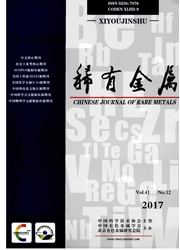

 中文摘要:
中文摘要:
通过高压反应釜辅助水相法快速且低成本地合成了荧光量子产率高、粒径均匀、纯度高以及光稳定良好的掺杂Zn的CdTe量子点,不仅降低了CdTe量子点的毒性,而且减少了对环境的污染。并且通过透射电子显微镜(TEM)、X射线衍射仪(XRD)、紫外分光光度计和荧光分光光度计对产物进行了表征。同时通过单因素实验,在制备过程中对CdTe∶Zn量子点的合成条件(包括pH、反应温度、反应物中Cd与Te,Cd与Zn的比例和配体巯基丙酸(MPA)含量等)进行优化得到了最佳的合成条件,即摩尔比Cd∶Te∶MPA=1.0∶0.5∶2.4,摩尔比Cd∶Zn=1.0∶1.0,pH=11和T=120℃,通过优化CdTe∶Zn量子点的合成条件不仅提高了纳米晶的质量,而且大幅度缩短了制备量子点的周期,且通过与CdTe量子点的比较得出掺杂Zn后量子点的生长速度和荧光强度均会提高。最后,采用外延生长法,在CdTe∶Zn核的表面包裹一层有更宽带隙的半导体材料ZnS,消除了量子点表面的悬空键及表面缺陷,并且对CdTe∶Zn/ZnS量子点进行了紫外和荧光表征,通过与CdTe∶Zn量子点的比较得出ZnS的加入进一步提高了量子点的荧光强度和光稳定性。
 英文摘要:
英文摘要:
The Zn-doped CdTe quantum dots (CdTe: Zn quantum dots) with high fluorescence quantum yield, uniform particles dis- tribution, high purity and good photostability were rapidly and low-costly prepared by autoclave-assisted aqueous phase synthesis. The CdTe: Zn quantum dots had less toxicity than CdTe quantum dots, which was environmentally beneficial. The quantum dots were char- acterized by transmission electron microscopy (TEM), X-ray diffraction (XRD), fluorescence and ultraviolet (UV) spectrophotome- ter. Besides, the most effective synthetic conditions for the preparation of CdTe: Zn quantum dots were obtained by optimizing the syn- thetic conditions including pH, reaction temperature, the ratios of Cd: Te and Cd: Zn, and the concentration of MPA through single fac- tor experiment. The optimal synthesis conditions were Cd: Te: MPA = 1.0: 0.5:2.4 ( mole ratio) , Cd: Zn = 1.0:1.0 ( mole ratio) , pH = 11 and T = 120 ℃. Optimizing the synthetic conditions of the CdTe: Zn quantum dots not only improved the quality of nanocrystals, but also significantly shortened the cycle time of the preparation of quantum dots. At the same time, compared with the CdTe quantum dots, the CdTe: Zn quantum dots displayed better growth rate and stronger fluorescence intensity. Meanwhile, CdTe: Zn was wrapped by ZnS semiconductor material with wider band gap through epitaxial growth method, removing dangling bond and surface defects. The CdTe: Zn/ZnS QDs were described by UV and fluorescence spectrophotometer, and showed better photostability and stronger fluores- cence intensity compared with CdTe: Zn quantum dots.
 同期刊论文项目
同期刊论文项目
 同项目期刊论文
同项目期刊论文
 Functionalized Magnetic Microparticles for Fast and Efficient Removal of Textile Dyes from Aqueous S
Functionalized Magnetic Microparticles for Fast and Efficient Removal of Textile Dyes from Aqueous S Synthesis of iron oxide coated fluoridated HAp/Ln3+ (Ln = Eu or Tb) nanocomposites for biological ap
Synthesis of iron oxide coated fluoridated HAp/Ln3+ (Ln = Eu or Tb) nanocomposites for biological ap Covalent Self-Assembly of Multi-Walled Carbon Nanotubes and Gold Nanoparticles for Detecting DNA Seq
Covalent Self-Assembly of Multi-Walled Carbon Nanotubes and Gold Nanoparticles for Detecting DNA Seq 期刊信息
期刊信息
